What do Fish Eat? Discovering the Varied Diet of Fish
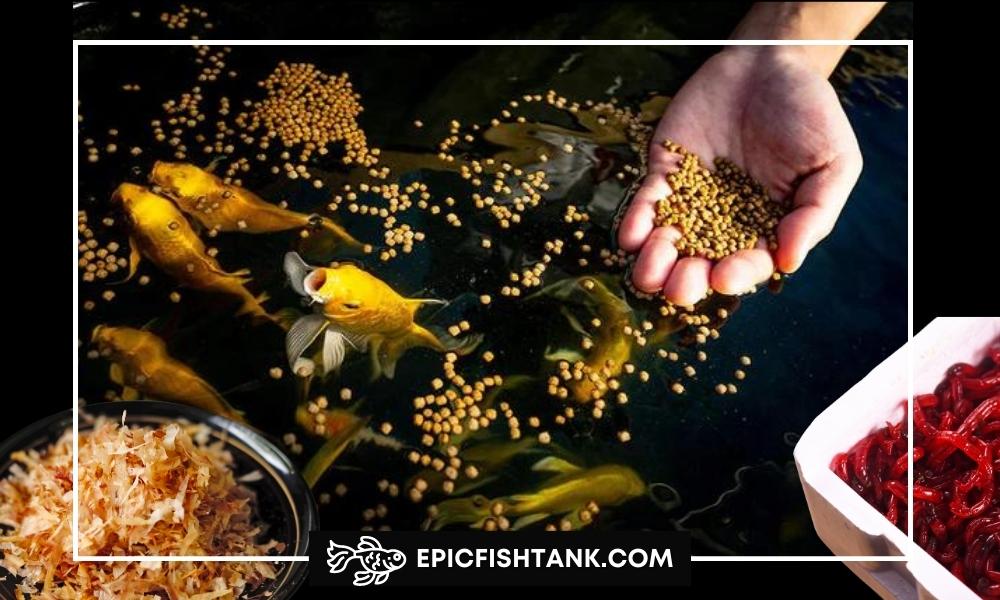
Have you ever wondered what fish eat?
In this blog post, we’ll explore the types of food that freshwater fish typically eat. We’ll also discuss some of the benefits of providing a varied diet for your fish.
With this information, you can ensure that your aquatic friends are getting all the nutrition they need! Let’s dive in!
Choosing the Right Type of Freshwater Fish Food
With so many different types of fish food available, it can be overwhelming to decide which one is best for your fish.
In this guide, we’ve compiled 5 key indicators to consider when choosing the right type of freshwater fish food. So, let’s dive in and explore these key indicators in detail.
| Key Indicator | Description |
|---|---|
| Nutritional Content | Ensure that the fish food you choose is nutritionally balanced and contains the necessary vitamins, minerals, and proteins for your fish’s health. |
| Fish Species | Different fish species have different dietary requirements, so choose fish food that is appropriate for the specific species you are keeping. |
| Feeding Habits | Consider the feeding habits of your fish, such as whether they are surface feeders or bottom feeders, and choose fish food that meets their feeding habits. |
| Water Quality | Choose fish food that does not pollute the water and maintains good water quality. Uneaten food can quickly decompose, leading to poor water quality and harmful bacteria growth. |
| Food Type | Consider the type of fish food you want to feed your fish, such as commercial food, live food, frozen food, or homemade food. Choose the type that offers the best benefits for your fish’s needs. |
EpicFishTank Note:
Protein is an essential nutrient for fish as it provides the building blocks for muscle growth, repair, and maintenance.
It also plays a crucial role in the immune system and other physiological processes. Therefore, it’s essential to ensure that your fish’s diet contains an adequate amount of protein.
Comparing Different Types of Fish Food: Pros and Cons
In this guide, we’ve compiled a list of the most popular types of fish food, including commercial fish food, frozen fish food, live fish food, and homemade.
We’ll explore the advantages and disadvantages of each type, as well as which fish species they’re best suited for.
To help you make the right choice, here’s a comparison of some of the most popular types of fish food:
| Type of Fish Food | Best for | Pros | Cons |
| Commercial Foods (flakes, pellets, freeze-dried, gel) | Community fish such as tetras, guppies, corydoras, platies, swordtails, and mollies. | Convenient, easy to store, long shelf life, well-balanced diet. | Can lose nutritional value if exposed to light, heat, or moisture, overfeeding can lead to obesity. |
| Frozen Food (shrimp, seafood) | Carnivorous or omnivorous fish such as cichlids, bettas, angelfish, discus, and rainbowfish. | Diverse and nutritious, stimulates natural feeding behavior. | Expensive, short shelf life, can introduce harmful bacteria or parasites if not properly handled. |
| Live Food (worms, insects, crustaceans) | Bottom-dwelling or predatory fish such as catfish, loaches, puffers, and some cichlids. | Natural diet, high in protein, stimulates natural feeding behavior. | Expensive, require extra care and maintenance, can introduce harmful bacteria or parasites if not properly handled. |
| Homemade Fish Food (cooked vegetables, fruits blended with eggs or yogurt) | All fish species. (Customizable) | Control of ingredients, diverse and nutritious. | Requires extra effort and time to prepare, and needs to ensure proper balance of nutrients. |
Betta fish eating blood worms video
EpicFishTank Note:
It’s important to research the specific needs of your fish species and consult with a veterinarian or fish expert if necessary to ensure a well-balanced and appropriate diet for your fish.
What Do Freshwater Fish Eat In The Wild
In the wild, freshwater fish have a diverse diet that can include a variety of organisms such as algae, insects, crustaceans, and other small aquatic animals. Let’s take a closer look at what some of the most popular freshwater fish eat in the wild:
| Fish Type | Description |
|---|---|
| Betta Fish | Betta fish in the wild primarily eat insects, mosquito larvae, and small crustaceans. |
| Goldfish | Goldfish are omnivores and in the wild, they feed on aquatic plants, small insects, crustaceans, and sometimes even smaller fish. |
| Guppies | Guppies are also omnivores and their natural diet in the wild consists of small invertebrates such as insects, crustaceans, and algae. |
| Tetras | Tetras are small fish that feed on a variety of small invertebrates such as insects, crustaceans, and zooplankton. |
| Angelfish | In the wild, angelfish feed on a diverse range of foods including algae, small crustaceans, insects, and other small fish. |
| Discus Fish | The diet of discus fish in the wild primarily consists of small invertebrates such as insects and crustaceans, as well as algae and aquatic plants. |
| Cichlids | Cichlids are known to have a varied diet in the wild, which can include algae, aquatic plants, insects, crustaceans, and even other fish. |
| Rainbow Fish | Rainbow fish feed on a variety of small invertebrates such as insects, crustaceans, and zooplankton, as well as algae and aquatic plants. |
| Catfish | In the wild, catfish are scavengers and will eat just about anything they can find, including algae, small invertebrates, and even dead fish. |
| Swordtails | Swordtails are omnivores and in the wild, they feed on a variety of small invertebrates such as insects and crustaceans, as well as algae and aquatic plants. |
EpicFishTank Note:
Cichlids, catfish and angelfish have the potential to eat other fish in the wild due to their aggressive behavior and varied diet
What do baby fish eat in the wild?
Baby fish, also known as fry, have different dietary requirements than adult fish. In the wild, the diet of baby fish varies depending on their species and their natural habitat. Some species of baby fish are herbivores and feed on algae, while others are carnivores and feed on other small organisms, such as zooplankton.
In general, most baby fish feed on small organisms such as rotifers, copepods, and other microscopic creatures found in their natural environment. They may also feed on newly hatched brine shrimp or small crustaceans. Some species of baby fish are also known to consume their own egg sacs or the eggs of other fish in their surroundings.
10 Popular Plant-Eating Fish
In this list, we’ve rounded up 10 popular plant-eating fish that are great choices for any aquarium enthusiast. So, let’s dive in and learn more about these fascinating creatures!
#1 Silver Dollars
Silver Dollars are peaceful fish that primarily feed on vegetation in the wild. They will also consume other plant-based foods in the aquarium such as lettuce and spinach.
#2 Siamese Algae Eaters
Siamese Algae Eaters are a popular choice for aquariums because they help keep the tank clean by consuming algae. They will also eat other plant-based foods such as spinach and zucchini.
#3 Bristlenose Plecos
Bristlenose Plecos are known for their ability to clean algae from aquariums. They also enjoy eating vegetables such as zucchini, cucumber, and spinach.
#4 Rosy Barb
Rosy Barbs are omnivores but will primarily feed on vegetation in the wild. They will also eat plant-based foods in the aquarium such as spirulina flakes and algae wafers.
#5 Hillstream Loach
Hillstream Loaches are known for their ability to consume algae in aquariums. They will also eat plant-based foods such as spinach, zucchini, and peas.
#6 Mollies
Mollies are primarily herbivores and will feed on a variety of vegetation in the wild. They will also eat plant-based foods in the aquarium such as spirulina flakes and algae wafers.
#7 Chinese Algae Eater
Chinese Algae Eaters are popular for their ability to clean algae from aquariums. They will also eat plant-based foods such as lettuce and spinach.
#8 Ghost Shrimp
Ghost Shrimp are omnivores but will primarily feed on algae and plant-based foods in the aquarium such as zucchini and cucumber.
#10 Kissing Gourami
Kissing Gouramis are primarily herbivores and will feed on a variety of vegetation in the wild. They will also eat plant-based foods in the aquarium such as spirulina flakes and algae wafers.
#10 African Cichlids
African Cichlids are known for their ability to consume algae in aquariums. They will also eat plant-based foods such as spirulina flakes and algae wafers.
EpicFishTank Note:
Plant-eating fish are generally considered to be more docile and gentle, preferring to feed on vegetation in the water rather than chasing after their prey.
These fish will often graze through the substrate or algae-based food sources throughout the day, rather than feeding twice daily like some carnivorous species.
It is important that these types of fish have a varied diet of both plant and animal material available to them, as this keeps them healthy and reduces the risk of malnutrition.
The 7 Bottom-Feeding Freshwater Fish & Their Diet
We’ll introduce you to six of the best bottom-feeding freshwater fish and their diets. So, let’s dive in and discover the diet of these amazing creatures!
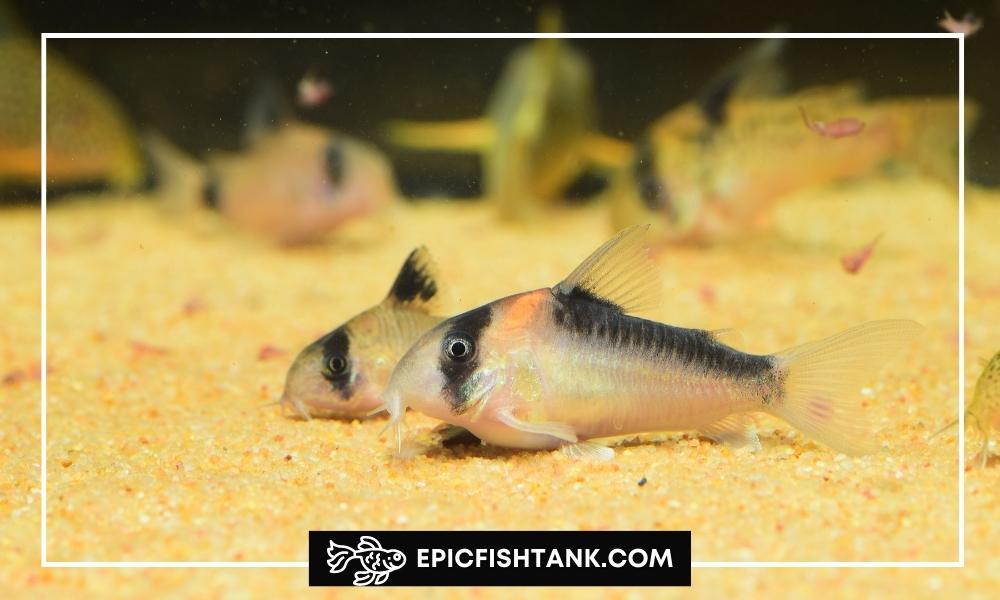
Corydoras Catfish
This fish prefers a diet of high quality sinking pellets and other fresh foods that they can easily scavenge from the substrate floor such as worms, insect larvae and small crustaceans.
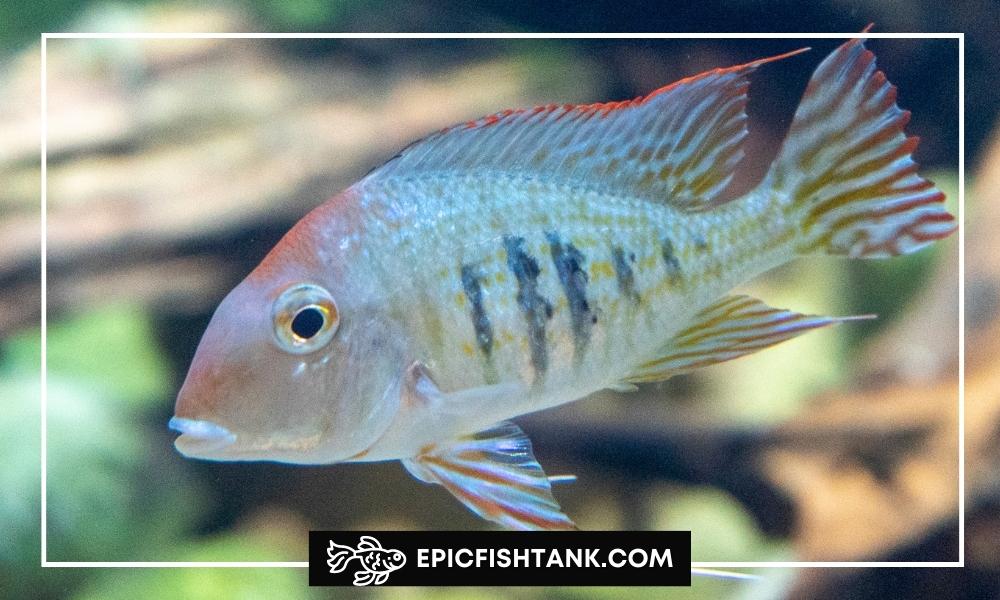
Geophagus
This omnivorous species is best fed with a diet of live foods such as blackworms, shrimp, brine shrimp, daphnia and mosquito larvae. They can also be fed flakes, freeze-dried or frozen foods.

Blotched Snowball Pleco
These fish will feed on detritus from the substrate as well as bloodworms, brine shrimp and other readily available prepared foods.
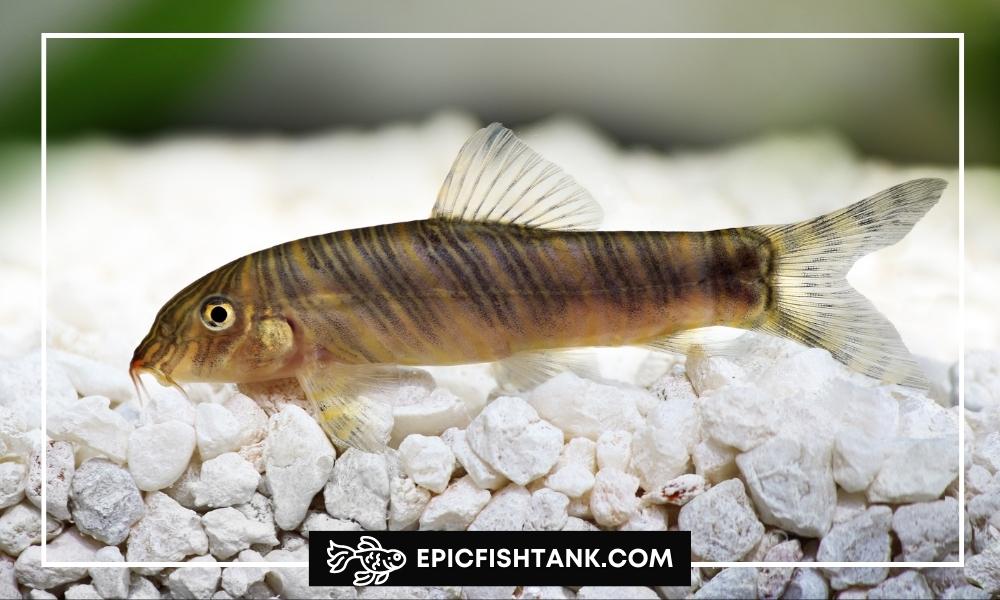
Zebra Loach
These freshwater loaches prefer a mostly carnivorous diet consisting mainly of small worms, crustaceans, insect larvae, plant matter (algae based) and small pieces of fresh or frozen seafoods.
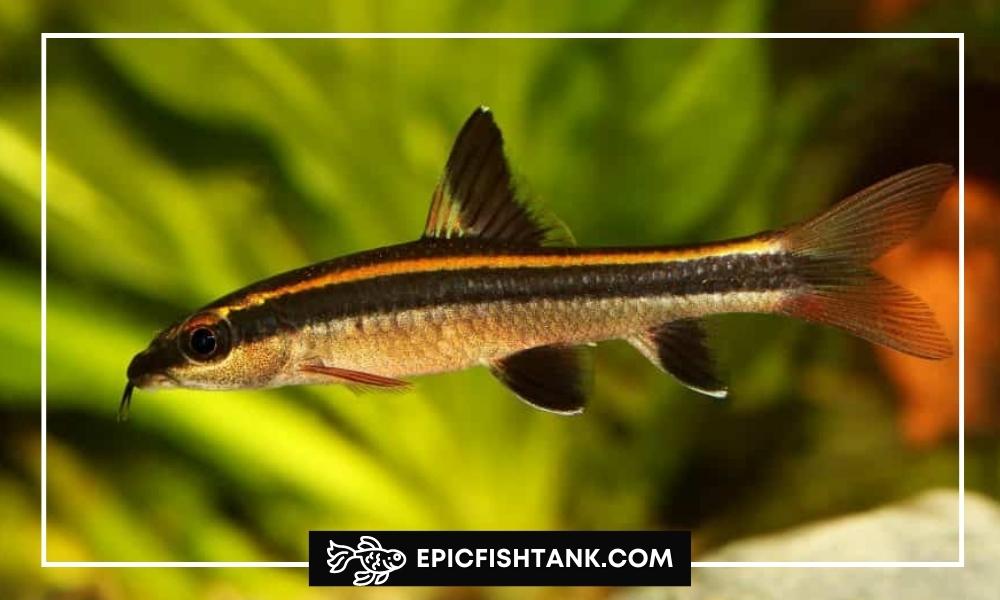
Flying Foxes
Generally an omnivore species that feeds on anything from filamentous algae to various crustaceans and insect larvae found in the substrate of the aquarium environment.

Spotted Raphael Catfish
This popular bottom feeder prefers a diet of algae, small invertebrates like worms and insects, and chopped-up fruits and vegetables.
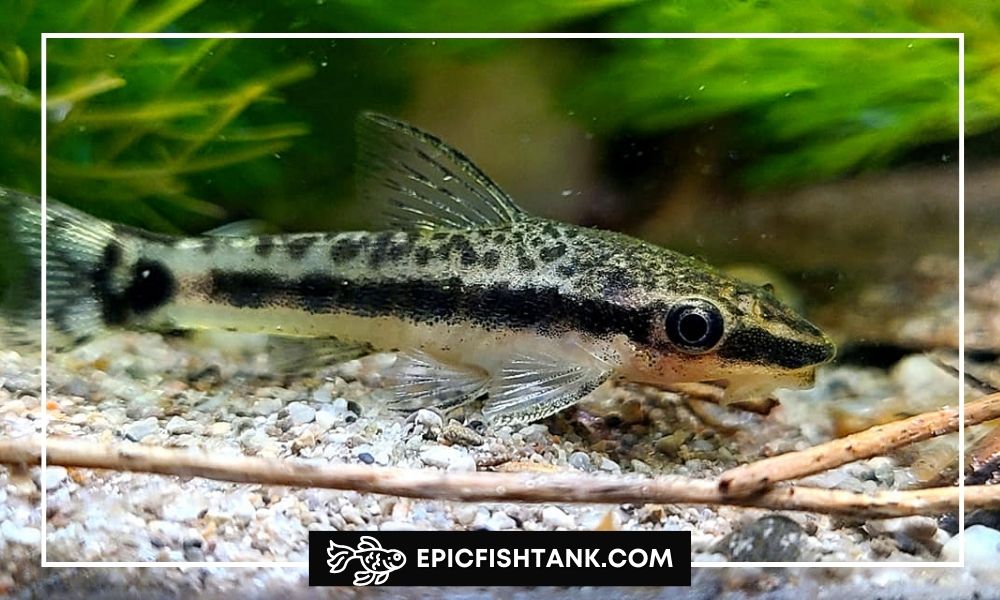
Otocinclus Catfish
The Otocinclus Catfish is an excellent candidate for a peaceful community fish tank. It feeds largely on algae, however, they may also feed on Algae wafers, Repashy Soilent Green gel food, and Green zucchini slices.
EpicFishTank Note:
In addition to their natural food sources, you can supplement their diet with commercial foods such as flakes or pellets specifically designed for bottom-feeders.
These foods contain essential vitamins and minerals that help keep your fish healthy. You can also feed them frozen or freeze-dried foods like shrimp, bloodworms, plankton, prawns, krill, mussels and more.
FAQs
This section provides answers to some of the most common questions related to what fish eat.
What can fishes eat besides fish food?
Fish can eat more than just fish food! In addition to a balanced fish food diet, you can also provide fresh vegetables, fruit, rice and even bread to your aquatic friends.
- Vegetables – Vegetables such as lettuce, spinach, peas and zucchini are all excellent sources of needed vitamins and minerals for your fish. You should be sure to cook them until they are soft enough for your fish to digest.
- Fruit – Fruits like apples, bananas or watermelons can be cut into small pieces and offered as snacks. It is important that the skin is removed before offering them to your fish.
- Rice – Cooked white or brown rice can be offered as a treat or an alternative to fish food. Be sure not to add any additional seasonings or oils when preparing the rice.
- Bread – Bread can also make a healthy snack for your fish if it is cooked until it is soft enough for them to digest it easily. Whole wheat bread is best for providing added nutrients to their diet.
Does fish food dissolve in water?
💡Yes. Certain types of fish food are designed to dissolve in water and provide an easy-to-use source of nutrition for your fish.
Some of the most common types of soluble fish food include:
- Gel food – Gel food is a nutrient-rich, semi-solid substance that comes in convenient packets or cubes. It can be easily measured and dissolved quickly in water. This type of fish food provides essential vitamins and minerals like calcium, phosphorus, and carotenoids.
- Flake food – Flake food is made from dried ingredients like shrimp, plankton, and other small organisms. It can provide essential nutrients but may not be as nutrient-dense as gel foods. Flake foods dissolve quickly in water but may contain fillers that could harm your fish if ingested.
- Frozen foods – Frozen foods come in the form of live prey like worms or brine shrimp. They offer high levels of nutrition but should only be given occasionally as they can carry parasites or bacteria that could harm your fish.
EpicFishTank Note:
Uneaten flakes may turn into mush and eventually dissolve, causing water contamination and potentially leading to water chemistry issues. Additionally, because they float, they may not be the best option for bottom feeders.
To minimize these issues, it’s important to feed your fish only what they can consume in a few minutes, and remove any uneaten food promptly. Performing regular water changes is also important to maintain good water quality and prevent build-up of dissolved food and other waste in the fish tank.
Final Words
Fish have a variety of dietary needs and preferences depending on the species and size. It is important to research the type of fish you are keeping in your aquarium to determine what kind of food they will best thrive on. With the right diet, any type of fish can live a healthy and happy life in an aquarium!
Reference
- Fisheries.tamu.edu | Understanding Fish Nutrition, Feeds, and Feeding
- Frontiersin.org | Fish Feed Intake, Feeding Behavior, and the Physiological Response of Apelin to Fasting and Refeeding
Time for a coffee break! With your support, We can keep working hard and creating fantastic content. #let's make it happen!
Author
Reza is a digital marketer and an avid freshwater aquarist. He's been keeping fish tanks for more than 10 years and has always been fascinated by the delicate balance of life in water.
Reza loves to share his knowledge about both digital marketing and fishkeeping with others, and he is always happy to help new aquarists get started in this rewarding hobby.
Wibisono is a freshwater fish breeder who raises and breeds different species of ornamental fish like betta, guppy, flowerhorn, and goldfish. He has been in the business since 2018 and exports his fish to different countries. He is committed to providing high-quality and healthy fish to his customers.


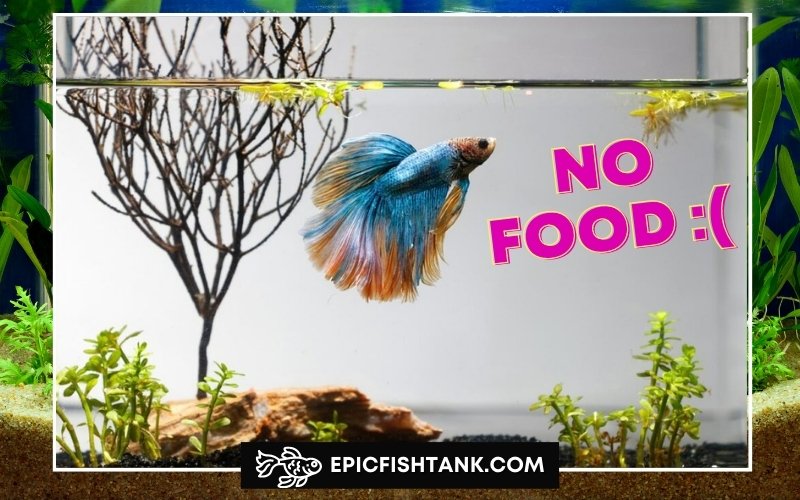
Leave a Reply